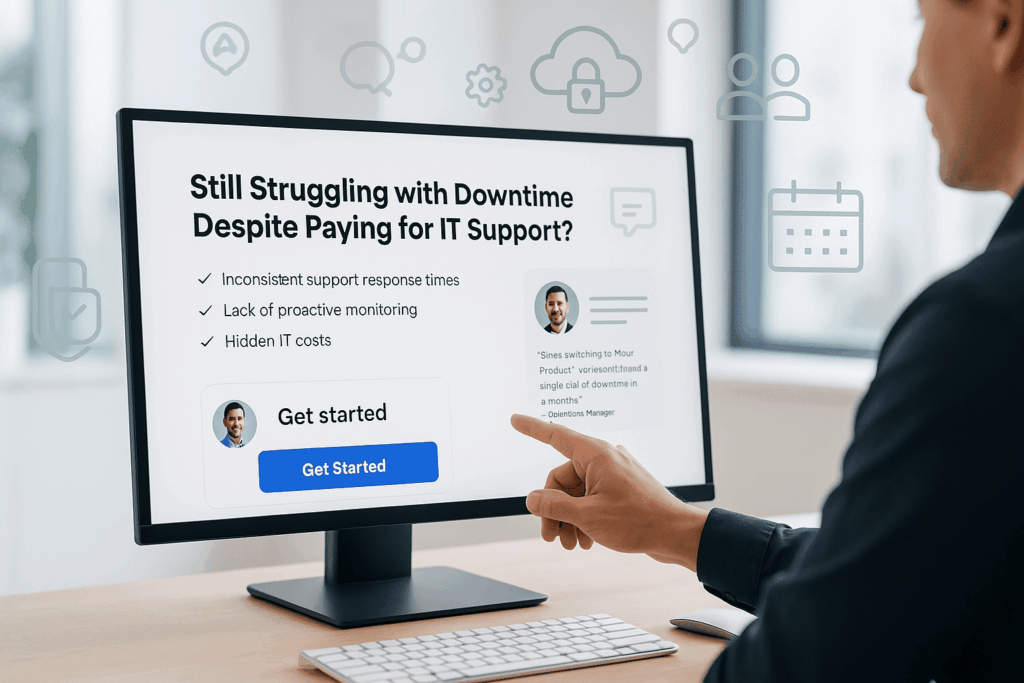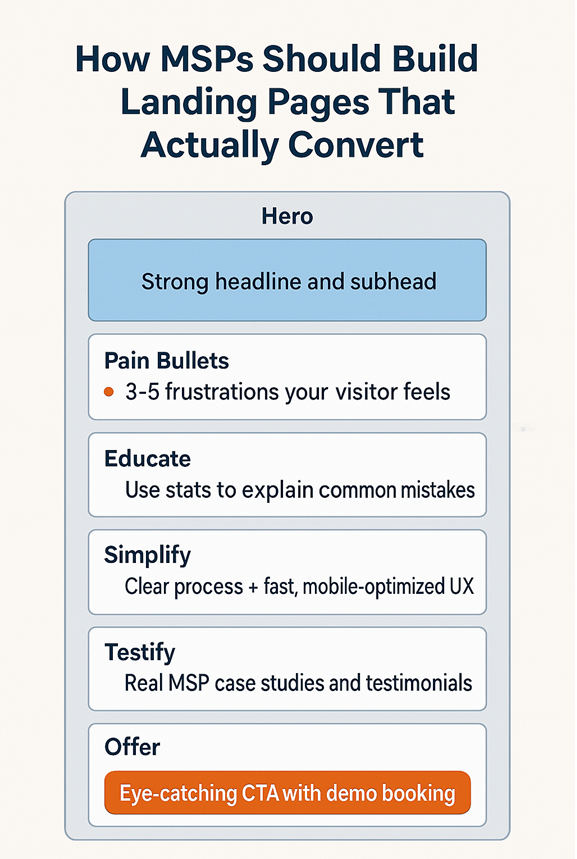Build Landing Pages That Convert for Your MSP

Most MSPs have a website, but very few have landing pages that convert. Whether you’re running Google Ads, launching a lead magnet, or promoting a service, sending traffic to a generic homepage just won’t cut it.
Landing pages are where interest becomes action. They guide visitors to take the next step, such as booking a call, downloading a resource, or requesting a quote. But too often, MSPs miss the mark with cluttered layouts, vague messaging, or zero follow-up.
Here’s how to build landing pages that work.
1. Start With the Pain
Your headline should call out a specific problem your audience feels.
Examples:
- “Still Struggling with Downtime Despite Paying for IT Support?”
- “Cybersecurity Threats Are Evolving. Is Your Business Ready?”
Use 3 to 5 short bullets to list the pain points:
- Inconsistent support response times
- Lack of proactive monitoring
- Hidden IT costs
This creates emotional relevance and hooks your visitor.
2. Show Empathy (Resonate)
After naming the problem, let prospects know you understand what they are going through. Use language that validates their experience.
Example:
“We have worked with dozens of local businesses who felt like their IT provider was just reactive. If you feel stuck dealing with surprise outages and vague answers, you’re not alone.”
This builds trust by showing you’re not just selling. You’re listening.
3. Educate With Clarity
Next, explain why the problem exists and how your approach solves it. Don’t dump jargon. Keep it clear and value-driven.
Example:
“Most IT problems do not come out of nowhere. They build up from missed updates, unmanaged endpoints, or poor visibility. Our proactive support plans monitor, patch, and alert before small issues become big disruptions.”
Consider adding a short explainer video or diagram to make your process tangible.
Also, keep your writing simple. Aim for a third-grade reading level. Avoid marketing buzzwords, technical acronyms, and industry-specific language. Your goal is to make it instantly clear to any visitor, no matter their background, what you offer and how it helps.
4. Simplify the Solution
Break down your offer into easy-to-understand components. Focus on benefits, not just features.
Instead of: “24/7 RMM, SIEM, and SOC support,” Say:
- 24/7 system monitoring
- Real-time threat detection
- Local team, you can call anytime
Use checklists, icons, or a simple “how it works” timeline to explain next steps.
5. Add Social Proof (Testify)
Real results build credibility. Include 2 to 3 testimonials or a short case study.
Example:
“Since switching to [Your MSP], we haven’t had a single day of downtime in 9 months. The team catches issues before we even notice them.” Operations Manager, Local Manufacturing Firm
Include photos or business names if you have permission.
6. Make a Clear Offer
End with a focused call to action. It should match the goal of your landing page:
Examples:
- “Book a Free IT Assessment”
- “Schedule a Cybersecurity Risk Review”
- “Get Our Free Guide: The 7 Questions to Ask Your MSP”
Keep the form short (name, email, phone max), and make the button clear and action-oriented:
[ Schedule My Free Assessment ]
If you are asking for a call to action, be direct. Make it easy to take the next step with the fewest clicks possible. Avoid long forms or extra confirmation pages. If the goal is to book a call, use a direct calendar link and let them choose a time instantly.
Landing Page Best Practices Checklist
- Every element in this checklist is a building block for trust, clarity, and conversion. Skipping any one of them could hurt your results. Treat your landing page like a storefront: it should be clean, clear, and inviting.
Quick Summary:
- Start by calling out a real pain your ideal client feels.
- Show you understand what they are dealing with.
- Educate them on the cause and your solution.
- Keep your message simple, benefits-focused, and jargon-free.
- Use testimonials or results from real clients.
- Create a strong, clear offer that is easy to act on.
- Remove friction with short forms and instant booking tools.
- Follow the checklist to stay on track with best practices.
- Always test and improve your page over time.

Final Tip: Test, Measure, Improve
The best landing pages are never truly done. Use tools like Google Optimize, Hotjar, or even simple A/B testing to try different headlines, button text, and form placements.
Small tweaks can drive major lifts in conversions over time.
To summarize: A successful MSP landing page starts by speaking to your audience’s pain, showing empathy, clearly explaining your value, simplifying your offer, backing it up with real proof, and closing with a strong, frictionless call to action. Write in plain language, avoid the tech and marketing jargon, and keep it simple enough for anyone to understand. Focus every element on making it easy to say “yes.”
Want examples of high-converting landing pages from other MSPs? Check out our resource section for templates, inspiration, and real-world case studies.
If you want a complete marketing system that includes industry-specific landing pages and automation built for MSPs, visit msphubhq.com and book a demo to see it in action.

